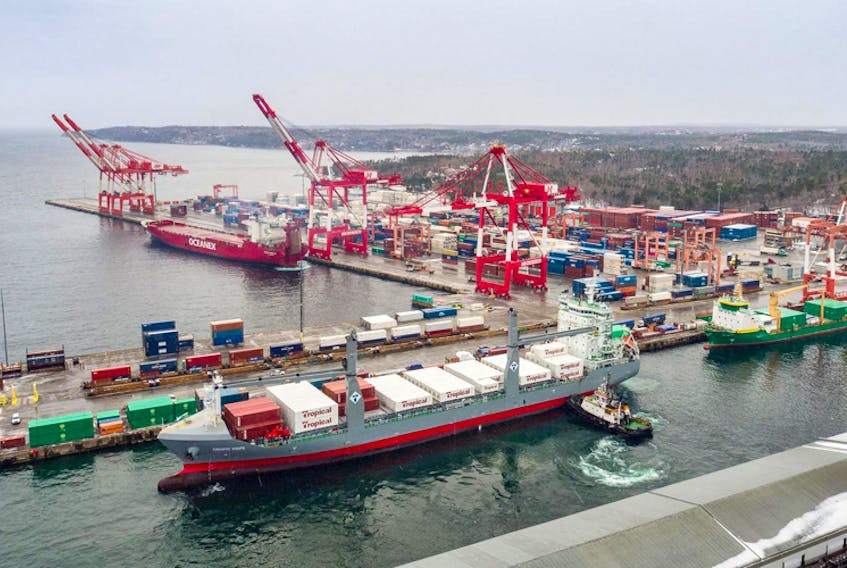EDITOR'S NOTE: This is the first in a five part series.
In Part 1 we look at the big picture on trade and introduce you to three Atlantic Canadian companies winning at the export game.
Coming Wednesday:
Atlantic Canadian exporters should be smiling this year thanks in part to several free trade agreements around the world, according to those who follow the industry.
"The federal government has established free trade agreements with most of the world (which) means Canada is in a good position because we are a trading nation," said Laurel Broten, president and chief executive officer of Nova Scotia Business Inc.
Fueled by American growth and new trade deals, exports are expected to buoy the gross domestic product of the region this year.
Final figures for Canadian exports for 2018 are not yet available, but early indicators are that Atlantic Canadian exporters saw a jump in business.
Exports contribute to GDP growth
In its mid-December outlook, the Atlantic Provinces Economic Council (APEC) noted exports were part of the reason for forecasted GDP growth of 1.2 per cent for New Brunswick and 1.3 per cent for Nova Scotia for the year.
On Prince Edward Island, exports declined in 2018, but APEC still forecast a 2.2 per cent growth in GDP based on higher household spending and residential investment.
Newfoundland and Labrador was expected to have GDP growth of 1.6 per cent due to declines in employment, retail sales, housing and major project investment.
Exporting insiders note the positive impact of Ottawa’s recent trade agreements with European Union (EU), the U.S. and Mexico, as well as the Pacific Rim.
In late September 2017, the Canada-European Union Comprehensive Economic and Trade Agreement wiped out most tariffs on Canadian goods headed for European markets. That's meant easier access to Europe and a bump in Canuck exports headed there.
"We are seeing an increase in export activity to the 28 European Union participating member countries since the (agreement) was ratified in September 2017," said Lane Farguson, spokesman for the Port of Halifax. "The increase is over six per cent which I would characterize as positive.”
After growing by an expected two per cent last year, the EU economy is expected to expand another 1.9 per cent in 2019, according to APEC's outlook.
New trade deal will stabilize outlook
With time running out on the North America Free Trade Agreement and no obvious replacement in sight, exporters and investors were jittery midway through 2018. Then, in late November, a comparable pact was signed by Canada, the U.S. and Mexico. It promises to stabilize the trading relationship between the countries.
Although there are still hurdles before the agreement becomes law, Export Development Canada (EDC) vice-president and chief economist Peter Hall is expecting the countries to come on board before the end of 2019.
"Ultimate approval is expected within the timeline, as quite frankly, it is in the best interests of not only the Trump Administration, but U.S. business, the general American public and by extension, elected officials, to do so," Hall wrote in early December.
"For similar reasons, we also expect passage to occur without serious hiccups in both Mexico and Canada.”
Until the pact is finalized, provisions of NAFTA remain in effect. Afterwards, some say Canada could eventually see a boost in some exports, including auto parts, to the States.
Canada exports 85 per cent of its vehicles to the U.S. and the new trade agreement ups the level of North American content in each vehicle, said Conference Board of Canada senior economist Julie Adès.
"The rules of origin are tighter, so now 75 per cent of the content in light vehicles must be sourced in North America. Before, it was 62.5 per cent.”
A big play for many Canadian exporters is access to new markets. Enter the Comprehensive and Progressive Agreement for Trans-Pacific Partnership.
It came into effect on Dec. 30 last year, and when fully implemented, will give Canadian exporters duty-free access to the other 10 signatory countries for 94 per cent of Canadian agricultural and agri-food products, 99 per cent of Canadian industrial products, and all Canadian fish, seafood and forestry products.
That free trade agreement between Canada and 10 countries in the Asia-Pacific region — including Australia, Chile, Japan, Malaysia, New Zealand, Peru, Singapore and Vietnam — creates a trading bloc with 495 million consumers and 13.5 per cent of the global GDP.
Other factors at play for export growth
Trade agreements, though, only set the stage for exporters. Other factors come into play in actually making sales, including fluctuating currencies, economic robustness, and product availability.
"The main factor influencing exports is not tariffs but demand in European Union and that has been growing, but slowly," said Marie-Christine Bernard, director of the Conference Board of Canada's provincial and territorial forecast service. "Exports are not disconnected from the economy.”
This year, New Brunswick's growth is forecast to slow to 1.1 per cent and Nova Scotia's to one per cent due to a drop in major project and housing investment. On Prince Edward Island, population increases are expected to support GDP growth of two per cent.
According to APEC's economic outlook, though, there's going to be an economic rebound in Newfoundland and Labrador where mining, major project investment and Hebron oil production promise to drive GDP growth of 2.9 per cent.
"After several years of declining major project investment, Newfoundland and Labrador will see spending rise by five per cent in 2019," that economic outlook forecasts. "Major project investment peaked in 2013 at $9.2 billion and dropped to $5.2 billion by 2018.
"The increase in 2019 is led by a peaking of work on Husky’s $3.2-billion West White Rose project and a ramping up of activity on Vale’s $2.2-billion Voisey’s Bay underground nickel mine. The increase in spending at these projects will more than offset the decline expected on the Muskrat Falls Hydro project, which is winding down further in 2019."
A growth story for Atlantic Canada
Provincial export growth numbers varied last year, according to Export Development Canada (EDC).
In 2019, while growth will moderate, the organization forecasts all provinces enjoying solid export growth against the backdrop of a more predictable trading environment with the announcement of the new U.S.-Mexico-Canada Agreement.
Success stories
These companies are doing export right. Click the portrait or the headline to explore our regional export success stories.

VIDEO: Charlottetown shop finds knitting niche

Sydney window manufacturer looking at future exposure in Middle East

Connections, products keys to success, says P.E.I. exporter

N.L. company exporting to almost 50 countries, aiming to be world leader










